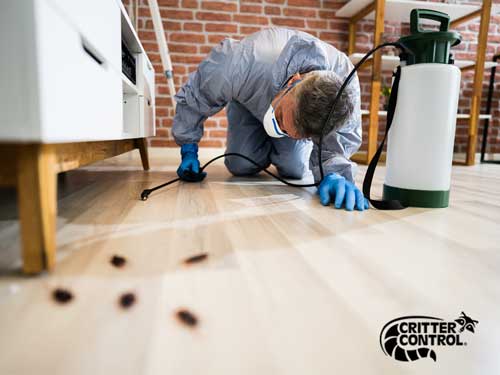A1 Bed Bug Exterminator Charlotte - Specialized Bed Bug Removal
A1 Bed Bug Exterminator Charlotte - Specialized Bed Bug Removal
Blog Article
Bed Bug Treatment Malfunction: Comparing Chemical Vs. Non-Chemical Solutions
In the realm of parasite control, particularly when managing the relentless problem of bed insects, the choice between chemical and non-chemical therapy solutions can be a pivotal one. Both strategies provide distinct benefits and disadvantages, affecting elements such as effectiveness, security factors to consider, and overall cost. By analyzing the nuanced details of each approach, a clearer understanding of which course to pursue in addressing a bed insect infestation can be obtained.
Efficiency of Chemical Treatments
Chemical treatments for bed bug invasions have actually been commonly identified for their potent and fast efficiency in eradicating these bugs. When considering the performance of chemical treatments, it is critical to understand that they can provide a extensive and fast option to a bed insect problem.
Furthermore, chemical therapies have the benefit of supplying recurring results, indicating that they can proceed to eliminate bed pests also after the preliminary application. This recurring activity is specifically helpful in combating any type of potential re-infestations. Additionally, the rapid activity of chemical therapies can bring relief to people facing severe bed bug infestations, permitting them to regain control of their space rapidly.
Safety And Security Concerns With Chemical Solutions
One crucial element that needs cautious factor to consider when using chemical options for bed bug treatment is making sure the security of owners and the setting. While chemical therapies can be efficient in getting rid of bed pests, they might posture threats otherwise dealt with correctly. One of the primary safety worry about chemical options is the potential harm they can create to human wellness. Direct exposure to particular chemicals used in bed bug therapies can result in respiratory problems, skin irritation, or various other unfavorable reactions, specifically in individuals with pre-existing problems or sensitivities. Additionally, improper application or dosage of chemical pesticides can lead to harmful residues sticking around in the treated location, presenting long-lasting health dangers to owners.
Moreover, the environmental influence of chemical options is an additional significant factor to consider. Some chemicals utilized in bed insect treatments may be unsafe to helpful bugs, wild animals, and ecosystems if they leach right into the dirt or water systems. It is important to use chemical therapies carefully, following safety standards, and taking into consideration much less harmful alternatives to alleviate these dangers and ensure the efficient and secure management of bed insect problems.
Advantages of Non-Chemical Techniques
Thinking about the possible safety issues and ecological effect connected with chemical solutions for bed pest treatment, exploring non-chemical techniques provides a promising option with numerous distinctive advantages. Non-chemical methods use a more secure option for houses, especially those with animals, individuals, or youngsters delicate to extreme chemicals. These approaches eliminate the threats of direct exposure to toxic compounds, reducing the potential for adverse health results. Additionally, non-chemical therapies are environmentally pleasant, as they do not add to air or water air pollution, making them a sustainable choice for bug control.
Additionally, non-chemical services can be efficient in targeting bed insects, consisting of hard-to-reach areas where chemical therapies may not pass through - A1 bed bug treatment in charlotte. Techniques such as heat therapy, vacuuming, vapor cleansing, and bed mattress encasements offer comprehensive eradication without the usage of dangerous chemicals.
Limitations of Non-Chemical Treatments

Furthermore, non-chemical treatments often call for numerous applications to accomplish effective removal. This can be time-consuming and might not always ensure full elimination of all bed insects and their eggs, especially in surprise or hard-to-reach areas.
Additionally, the success of non-chemical treatments greatly relies upon proper execution and thoroughness, which can be challenging for individuals without expert know-how. Inadequate application of non-chemical techniques may lead to incomplete obliteration, leading to persistent problems and the requirement for added therapies.
As a result, while non-chemical therapies have their advantages, it is crucial to recognize see here these limitations and consider them when figuring out one of the most efficient approach for managing bed insect infestations.
Price Comparison: Chemical Vs. Non-Chemical Options
Provided the restrictions linked with non-chemical treatments, an essential aspect to examine in the context of bed bug monitoring is the expense contrast in between chemical and non-chemical alternatives. In contrast, non-chemical therapies like heat treatment or steam can be much more pricey, with prices ranging from $1,000 to $6,000 for a whole home. While the preliminary cost of chemical therapies may appear reduced, multiple treatments might be needed to fully remove the infestation, potentially boosting the total price.
Conclusion

Taking into consideration the possible safety problems and ecological influence connected with chemical options for bed insect therapy, exploring non-chemical methods provides a promising alternative with several unique benefits.Offered the limitations associated with non-chemical treatments, an important element to evaluate in the context of bed bug monitoring is the cost contrast in between chemical and non-chemical choices. In comparison, non-chemical therapies like heat treatment or heavy steam can be a lot more expensive, with prices varying from $1,000 to $6,000 for an entire home. While the initial cost of chemical therapies might appear reduced, several therapies may be needed to completely eliminate the infestation, possibly boosting the total cost.In verdict, when comparing chemical and non-chemical bed bug treatment options, it is important to think about efficiency, security, advantages, constraints, and expense.
Report this page